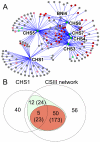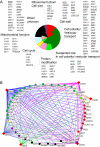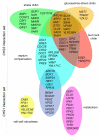An interactional network of genes involved in chitin synthesis in Saccharomyces cerevisiae
- PMID: 15715908
- PMCID: PMC554099
- DOI: 10.1186/1471-2156-6-8
An interactional network of genes involved in chitin synthesis in Saccharomyces cerevisiae
Abstract
Background: In S. cerevisiae the beta-1,4-linked N-acetylglucosamine polymer, chitin, is synthesized by a family of 3 specialized but interacting chitin synthases encoded by CHS1, CHS2 and CHS3. Chs2p makes chitin in the primary septum, while Chs3p makes chitin in the lateral cell wall and in the bud neck, and can partially compensate for the lack of Chs2p. Chs3p requires a pathway of Bni4p, Chs4p, Chs5p, Chs6p and Chs7p for its localization and activity. Chs1p is thought to have a septum repair function after cell separation. To further explore interactions in the chitin synthase family and to find processes buffering chitin synthesis, we compiled a genetic interaction network of genes showing synthetic interactions with CHS1, CHS3 and genes involved in Chs3p localization and function and made a phenotypic analysis of their mutants.
Results: Using deletion mutants in CHS1, CHS3, CHS4, CHS5, CHS6, CHS7 and BNI4 in a synthetic genetic array analysis we assembled a network of 316 interactions among 163 genes. The interaction network with CHS3, CHS4, CHS5, CHS6, CHS7 or BNI4 forms a dense neighborhood, with many genes functioning in cell wall assembly or polarized secretion. Chitin levels were altered in 54 of the mutants in individually deleted genes, indicating a functional relationship between them and chitin synthesis. 32 of these mutants triggered the chitin stress response, with elevated chitin levels and a dependence on CHS3. A large fraction of the CHS1-interaction set was distinct from that of the CHS3 network, indicating broad roles for Chs1p in buffering both Chs2p function and more global cell wall robustness.
Conclusion: Based on their interaction patterns and chitin levels we group interacting mutants into functional categories. Genes interacting with CHS3 are involved in the amelioration of cell wall defects and in septum or bud neck chitin synthesis, and we newly assign a number of genes to these functions. Our genetic analysis of genes not interacting with CHS3 indicate expanded roles for Chs4p, Chs5p and Chs6p in secretory protein trafficking and of Bni4p in bud neck organization.
Figures






Similar articles
-
A septin-based hierarchy of proteins required for localized deposition of chitin in the Saccharomyces cerevisiae cell wall.J Cell Biol. 1997 Oct 6;139(1):75-93. doi: 10.1083/jcb.139.1.75. J Cell Biol. 1997. PMID: 9314530 Free PMC article.
-
Differential trafficking and timed localization of two chitin synthase proteins, Chs2p and Chs3p.J Cell Biol. 1996 Nov;135(3):597-610. doi: 10.1083/jcb.135.3.597. J Cell Biol. 1996. PMID: 8909536 Free PMC article.
-
Chs7p, a new protein involved in the control of protein export from the endoplasmic reticulum that is specifically engaged in the regulation of chitin synthesis in Saccharomyces cerevisiae.J Cell Biol. 1999 Jun 14;145(6):1153-63. doi: 10.1083/jcb.145.6.1153. J Cell Biol. 1999. PMID: 10366589 Free PMC article.
-
Biosynthesis of cell wall and septum during yeast growth.Arch Med Res. 1993 Autumn;24(3):301-3. Arch Med Res. 1993. PMID: 8298281 Review.
-
Chitin synthases in yeast and fungi.EXS. 1999;87:55-69. doi: 10.1007/978-3-0348-8757-1_4. EXS. 1999. PMID: 10906951 Review.
Cited by
-
Direct link between RACK1 function and localization at the ribosome in vivo.Mol Cell Biol. 2009 Mar;29(6):1626-34. doi: 10.1128/MCB.01718-08. Epub 2008 Dec 29. Mol Cell Biol. 2009. PMID: 19114558 Free PMC article.
-
The 'interactome' of the Knr4/Smi1, a protein implicated in coordinating cell wall synthesis with bud emergence in Saccharomyces cerevisiae.Mol Genet Genomics. 2006 Mar;275(3):217-30. doi: 10.1007/s00438-005-0082-8. Epub 2005 Dec 16. Mol Genet Genomics. 2006. PMID: 16362369
-
Yeast Gup1(2) Proteins Are Homologues of the Hedgehog Morphogens Acyltransferases HHAT(L): Facts and Implications.J Dev Biol. 2016 Nov 5;4(4):33. doi: 10.3390/jdb4040033. J Dev Biol. 2016. PMID: 29615596 Free PMC article. Review.
-
Genome-Wide Identification of SNARE Family Genes and Functional Characterization of an R-SNARE Gene BbSEC22 in a Fungal Insect Pathogen Beauveria bassiana.J Fungi (Basel). 2024 May 31;10(6):393. doi: 10.3390/jof10060393. J Fungi (Basel). 2024. PMID: 38921379 Free PMC article.
-
Chitosan, the deacetylated form of chitin, is necessary for cell wall integrity in Cryptococcus neoformans.Eukaryot Cell. 2007 May;6(5):855-67. doi: 10.1128/EC.00399-06. Epub 2007 Mar 30. Eukaryot Cell. 2007. PMID: 17400891 Free PMC article.
References
Publication types
MeSH terms
Substances
Grants and funding
LinkOut - more resources
Full Text Sources
Other Literature Sources
Molecular Biology Databases

